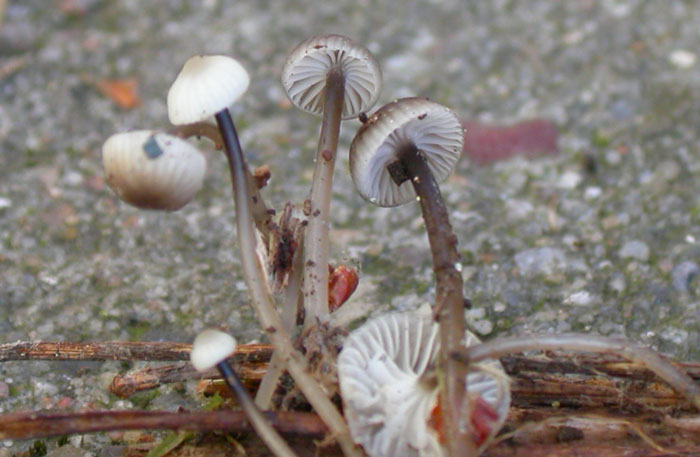Pileus up to 8.5 mm across, parabolical
to convex,translucent-striate, glabrous, viscid, covered
with a gelatinous, elastic, separable pellicle, at first
blackish grey to dark grey with white margin, (or in some
small specimens, entirely whitish), becoming slate grey
with whitish margin. Flesh thin, whitish. Odour hardly distinctive,
reminiscent of M. vulgaris. Lamellae 14 – 15 reaching
the stipe, arcuate, broadly adnate, decurrent with a tooth,
fairly thick, white, the edge concolorous, concave, separable
as an elastic-tough thread. Stipe up to 40 x 1 mm, hollow,
tenacious, terete, equal, straight to flexuous, glabrous,
viscid, covered with a separable, gelatinous pellicle, at
first black at the apex and dark grey farther below, finally
grey to grey-brown, mostly with the apex blackish grey,
the base covered with long, coarse, flexuous, white fibrils.
Basidia 23-30 x 5.5-7 µm, with sterigmata
up to 4.5 µm long, 4-spored, clamped. Spores 7.4-8.2(-9)
x 3.5- 4.5 µm, (narrowly) pip-shaped, smooth, amyloid
Cheilocystidia forming a sterile band, clamped, embedded
in gelatinous matter, cylindrical, terminated with much
branched gelatinizing excrescences. Pleurocystidia absent.
Hyphae of the pileipellis embedded in gelatinous matter,
smooth, with much branched and diverticulate sidebranches.
On the central nerves of fallen, decayed leaves
of Populus tremula and among litter under Pinus.
S-Norway: Vestfold, Nøtterøy,
Torød, 5 Oct. 2003. A. Aronsen A 46/03.
--------
A striking character of this taxon is the
blackish to dark grey pileus and the black apex of the stipe.
I have never seen these colours in Mycena vulgaris. Otherwise
there is not much separating it from M. vulgaris. The microscopy
is identical with M. vulgaris.

|